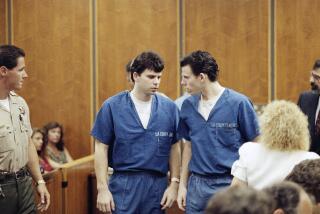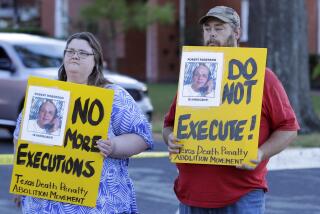Relief delayed for prisoners deemed wrongfully convicted
Justice delayed was justice denied for Omer Harland Gallion. He died in prison in his sixth year of waiting for U.S. District Judge Percy Anderson to act on a decision that he had been wrongfully convicted and should be released or retried.
Anderson took no action until December, when he dismissed the matter as moot after an attorney brought Gallion’s death to his attention.
Two other cases in which junior judicial officials found grounds for striking prisoners’ felony convictions also languished unattended by Anderson for five and a half and eight years, respectively. Another prisoner who petitioned for relief in 2002 is still waiting for an answer.
Prisoners who appeal to federal judges with claims of wrongful conviction are rarely successful in their quests for relief, known as writs of habeas corpus, “the great writ” that is a hallmark of American justice. Only 1 in 284 petitions is approved, according to a 2006 report by a Vanderbilt University law professor. But ignoring recommendations for relief in the few meritorious cases among the 17,000 or so filed each year raises concern about a judge’s objectivity, judicial scholars say.
Anderson declined to discuss the delays. Legal experts say the years-long inaction is highly unusual, even given the complexity of many habeas petitions that raise dozens of issues about the fairness of a prisoner’s trial and sentence. Some attribute the delays to the court’s staggering caseload and judges’ obligation under the Speedy Trial Act to give priority to pending criminal cases. Others question Anderson’s objectivity in prisoners’ cases and speculate that he may be dismissive of their claims of mistreatment.
The chief judge for the Central District of California defended Anderson, describing the long delays as “extremely unfortunate” but blaming them on the district’s huge caseload.
“Judge Anderson is an excellent judge,” said Chief Judge Audrey B. Collins. “I have absolutely no reason to believe there was any bias that permeated his handling or played any part whatsoever in this.” She noted that the district’s 25 active judges carry caseloads that should be spread among at least 36.
Judicial scholars and defense attorneys say Anderson’s handling of the habeas cases raises concern and should lead to a misconduct inquiry.
“The delay is what makes this troubling,” said Arthur Hellman, a University of Pittsburgh law professor and expert on the federal judiciary. “The delays are unexplained. It certainly raises concerns that are going to persist as long as there’s no explanation.”
A Times review of Anderson’s record found that 565 habeas cases, excluding death row appeals, have been assigned to the judge during his nine years on the bench. He accepted the reviewing magistrate’s recommendations to grant relief in two cases assigned early in his tenure and dealt relatively quickly in denying or dismissing the rest of those in which he has issued rulings. That swift dispatch of denials contrasts with the three long-delayed rulings on recommended grants that were brought to public attention last month by the Daily Journal, a legal publication.
“It brings to mind the comment by one of the James Bond characters: ‘Once is happenstance, twice is coincidence, but three times is enemy action,’ ” said Hellman, quoting Ian Fleming’s “Goldfinger.”
“It’s not enough to reach a conclusion but enough to raise concern and enough, in my mind, to raise the desirability of a misconduct inquiry,” he said. “The misconduct process doesn’t exist just to discipline judges who do unethical things, but also to assure the public that the judiciary cares, as an institution, that individual judges are doing their jobs right without any kind of animus or improper attitudes.”
U.S. 9th Circuit Court of Appeals Chief Judge Alex Kozinski has the authority, as head of the Judicial Council, to make a public inquiry into any concerns about potential misconduct, even without a formal complaint, which would be investigated in secret. Asked if he planned to question Anderson on why he failed to act expeditiously in the three cases, Kozinski said he couldn’t comment “on any matter potentially involving judicial discipline.”
Sean Kennedy, federal public defender for the Central District, said that none of the cases in which Anderson delayed rulings was represented by lawyers in his office. But he said he was concerned about the judge’s handling of the three cases.
“If a district judge promptly accepts every recommendation to deny a habeas petition, but sits for years on the very few recommendations to grant relief, it causes petitioners to question the fairness of the proceedings,” said Kennedy, head of the largest public defender agency in the country.
All federal judges are required under the Civil Justice Reform Act to report any cases pending for three years or more, and 17 of 18 cases in Anderson’s latest report involve habeas petitions or other prisoners’ rights issues. For the entire Central District, which spans a population of 19 million over seven counties, there are 265 habeas cases still waiting for rulings after three years or more, Collins said.
Gallion, the petitioner who died in prison, had no attorney representing him for the last five years. Of the other two prisoners deemed by reviewing magistrates to have been wrongly convicted, one’s request to be represented by a volunteer defense attorney was blocked by Anderson and the other’s lawyer has declined to discuss the case before consulting with his client.
The attorney thwarted in his attempt to represent prisoner Randall Amado is unequivocal in his view that Anderson harbors bias against convicts, even when other jurists have found those convictions to be unjust. Amado’s conviction for felony murder on the testimony of a rival gang member and convicted felon facing his own murder trial called into question the reliability of the witness and the fairness of Amado’s trial, a magistrate judge ruled in 2003. The magistrate urged Anderson to order him released or given a new trial.
“The idea that this can just sit there and languish for years!” said an exasperated John Lanahan, the San Diego attorney who wrote Amado’s petition for counsel midway into the prisoner’s eight-year wait for Anderson to act. “It’s pretty clear that he has no problems ruling fast when the recommendation is that the petition should be denied.”
Anderson denied the writs for Amado and for spousal abuse convict Adilao Juan Ortiz on July 20, the same day that the Daily Journal sought an explanation from the judge for the delays.
Lanahan said Anderson’s failure to rule on Amado’s request for counsel was particularly frustrating because there was no avenue of appeal, as there would have been if the judge had denied it.
“There is consistent animus with Percy Anderson. He puts you in a place where you can’t get there from here,” Lanahan said. “Inaction is definitely worse than denial.”
Anderson, named to the Los Angeles-based federal court by President George W. Bush in 2002, also experienced the implied censure five years ago of being removed from a case in which a former prisoner was suing the government for wrongful rape conviction in 1986. A federal appeals court ruled that Anderson’s actions during trial of the lawsuit brought by Herman Atkins led the panel to conclude that Anderson’s “impartiality might be questioned.”
Vanderbilt University law professor Nancy J. King, a leading habeas scholar, argues that the system intended to give wronged prisoners a final chance at relief has become widely abused and should be limited to state prisoners who have claims of actual innocence, not procedural missteps.
As Supreme Court Justice Robert H. Jackson famously noted in a 1953 habeas ruling, King recalled, “He who must search a haystack for a needle is likely to end up with an attitude that the needle is not worth the search.”
More to Read
Sign up for Essential California
The most important California stories and recommendations in your inbox every morning.
You may occasionally receive promotional content from the Los Angeles Times.











